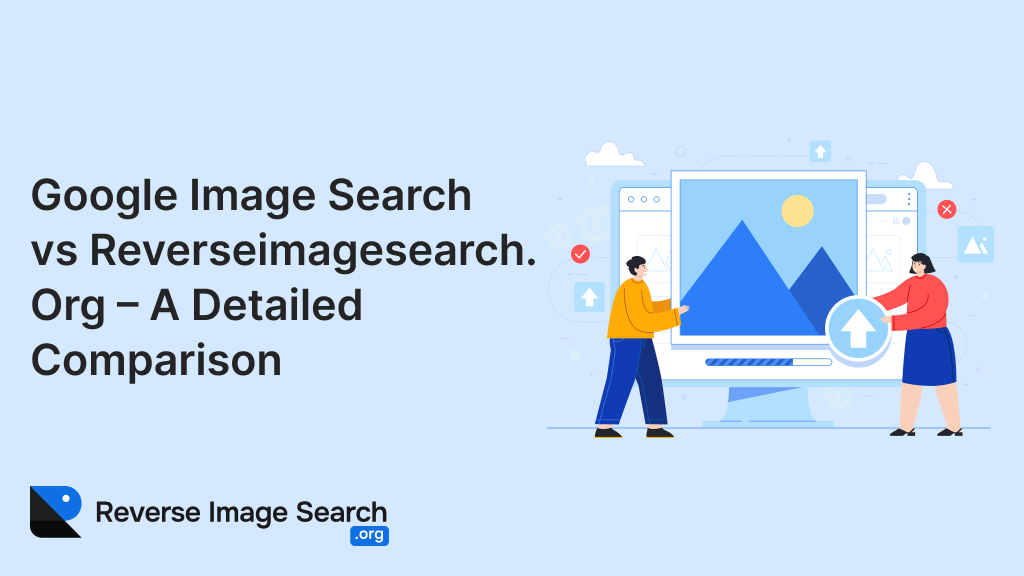
Visual search has changed the way we find and verify images online. It has made significant advancements in various industries for identifying objects and people. These tools come in handy for tracing the origin of pictures, checking for duplicates, or verifying authenticity.
In this case, two popular choices are Google Image Search and Reverseimagesearch.org. Both platforms offer advanced features that are quite similar. So, we’ll compare the features and real-world uses of both to determine which one works best.
But before that, let’s understand what reverse image search is.
What is Reverse Image Search?
Reverse image search is a popular technology that allows users to find information about an image. Users can search by keyword or the image itself. Unlike traditional searching techniques, users add a query image instead of text-based keywords. The technology analyzes the photo and then searches for matching images, websites, and information across the web
Google Image Search Vs ReverseImageSearch.org
Both of these platforms have the same features and functionality. They are excellent in their work. However, there are some minor differences in efficiency. So, let’s have a detailed breakdown of all their performances.
Accuracy and Database
Google image search has a massive database of online photos. It performs really well when you search for popular or widely used images. Google will find the required visuals easily if the picture is trending or has been on websites or blogs. However, it may struggle with less common images or graphics that are not indexed in its system.
ReverseImageSearch.org also delivers accurate matches for searched images. The tool has its own extreme database, which gives it a wider reach when finding images, even if those images are not widely circulating. It’s more likely to find an image that cannot be located through traditional search methods.
Speed and Performance
If we talk about the performance of these search tools, both show excellent results. However, they work differently. Google’s results appear almost instantly, but they might come with other unrelated content, such as ads or web pages. It’s fast but can be irritating for some people.
Meanwhile, ReverseImageSearch.org focuses only on retrieving information relevant to the image. It shows matches quickly and keeps the experience clean. It processes the image immediately as it uploads and delivers accurate matches along with their sources.
Ease of Use
Everybody is familiar with Google’s interface. It has a clear search bar where you can type and search for anything. Most users know how it works since it’s tied to the main search engine. However, to conduct a search with a photo, users need to follow extra steps or switch to the desktop version.
On the other hand, ReverseImageSearch.org makes the process direct. Just upload an image, drag or paste it, and the results appear without extra clicks. It is designed only for image searches, making it lighter and more user-focused.
Privacy and Data Handling
The basic function of Google is to provide services as a search engine. So, it collects user data to personalize results. When you upload an image, it will be stored in the image database. It raises privacy concerns for people searching for sensitive or personal images. So, if you do not want your photos to be collected, use the other option.
This is the opposite for ReverseImageSearch.org, as it does not store uploaded visuals. It is made for people who care about privacy. Once the search is complete, the file is removed from their system even if the user has registered an account.
Multi-Engine Search Capability
Although Google is powerful, it is limited to just one source. It can only show what it finds from its own image database. If the specific visuals are not already available in the database, it won’t show any results.
However, ReverseImageSearch.org retrieves visual data from multiple platforms and delivers it in one place. It does not rely on a single platform to fetch results. So, instead of searching for the same thing on different sites, you get everything in one go.
Cross-Device Compatibility
Google is highly compatible with desktop as well as mobile search. However, users with previous models of phones may find it tricky. They might need to use desktop mode or take extra steps just to upload an image.
ReverseImageSearch.org is fully mobile-friendly. You get the same features and a smooth process regardless of the device you are using. It is a web-based tool, so all you need is a web browser on any device.
Specific Use Cases
Use Google Search by Image When:
- You need to identify a famous person, product, or trending meme.
- Searching for high-ranking or viral content on the Internet.
- You are casually browsing or gathering reference images for projects.
Use ReverseImageSearch.org When:
- You want to find the original source of a image.
- Checking for image misuse or duplicates across platforms.
- You are handling professional or sensitive visual content.
- You want broader, cross-platform results in one place.
- You need fast and focused results without web clutter.
The Right Choice
Both of these image search platforms provide accurate results at a good speed. They do their job well, but they have expertise in different areas. Google Image Search is reliable for mainstream queries. On the other hand, Reverseimagesearch.org provides a sharper, more flexible experience, especially when you are looking for professional use. Therefore, instead of picking a winner, choose the one that fits your needs at the moment.
